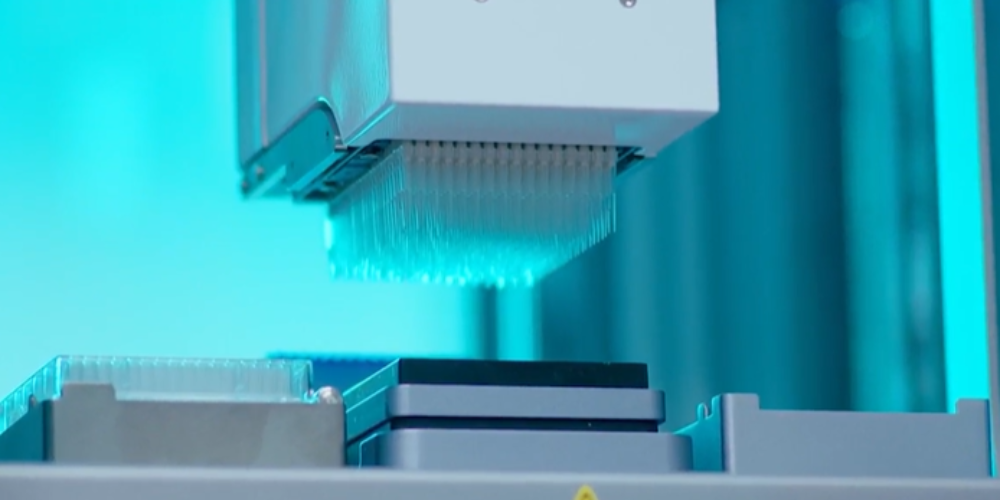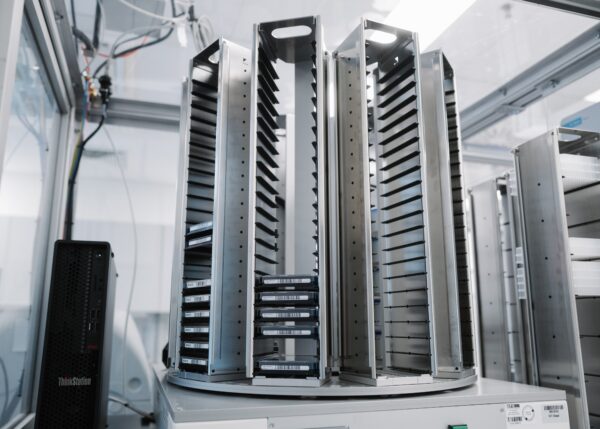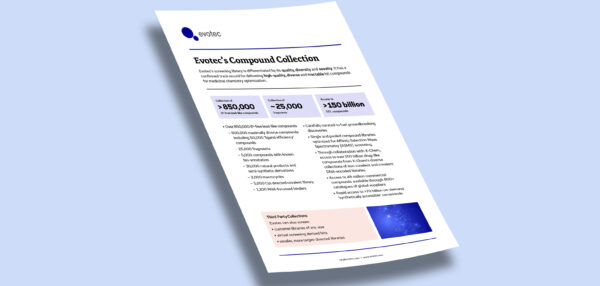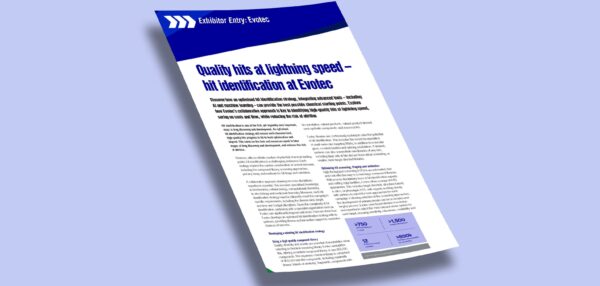High throughput screening (HTS) is one of the most widely used methods for hit identification. It involves screening large libraries of compounds (often hundreds of thousands or more) against a biological target in a rapid and automated manner.

The expansion of Evotec's screening capacity in Hamburg is Supported with a grant under the REACT-EU program.
Learn more about the EFRE/REACT-EU-Grant.
Evotec is a global leader in HTS, offering one of the most advanced and comprehensive technology platforms in the world, combined with a vast wealth of expertise and experience in a range of modalities. Flexible solutions are available including standalone single or multi-target HTS services, as well as fully integrated lead discovery support. In the past 5 years, over €12 million has been invested in the HTS facilities, increasing efficiency and throughput for a wide variety of detection technologies. The company prides itself on the quality of its screening collection of over >850,000 compounds. This collection provides access to diverse and novel biologically relevant chemical space, and the compounds have been selected for their chemical tractability and drug-likeness.
Rapid high throughput screening
Why Choose Evotec as your CRO for High Throughput Screening?
Experience and Consultancy in HTS
In 2000, Evotec launched the first high-throughput screening system in miniaturised format. To date, Evotec has developed > 1,500 tailored assays and miniaturized >750 cell-based, microorganism-based and biochemical assays for use in HTS campaigns. Over the past 5 years, >5,000 proteins and approx. 1,600 cell lines have been produced and >1,750 protein ligand complexes have been delivered.
Significant knowledge and expertise are available to deliver novel modalities and we offer all major screening platforms and readout technologies. Evotec’s multi-disciplinary team includes experts in biochemistry, computational chemistry, in vitro biology, medicinal chemistry and automation. With an excellent combination of disease biology knowledge as well as drug discovery and development expertise, Evotec selects the most suitable screening strategy for your target class and therapeutic area of interest.
Expansive and High-Quality Compound Collection for HTS
Discover a treasure trove of tractable chemical starting points in Evotec's extensive collection of compounds, carefully curated to fuel groundbreaking discoveries. Evotec’s screening library of >850,000 carefully curated compounds is differentiated by its quality, diversity and novelty and has a confirmed track record of delivering chemically tractable and attractive lead-like hit compounds representing suitable starting points for medicinal chemistry optimisation. Our compound libraries are available as single compounds but also in pools, optimised for affinity selection mass spectrometry screening (ASMS). Furthermore, Evotec has access to >150 billion DNA tagged compounds for DNA-encoded library (DEL) screening through its collaboration with X-Chem.
Our team of experts work with you to design the most suitable screening strategy for your target or phenotype. Evotec’s experience in HTS is vast and the facility has run more than 750 biochemical, cellular or micro-organism-based campaigns, and has developed >1,500 assays. The company has invested in 10 fully automated HTS platforms including BSL2+/3-enabled platforms for high throughput screening of microorganisms, ensuring rapid generation of robust data. Our state-of-the-art platforms employ a wide array of detection technologies enabling superior sensitivity in screening and detection of invaluable hits with high confidence. Stringent review processes ensures the selection and prioritization of the most promising compounds with the highest likelihood of success. Our capabilities include target-based approaches (e.g., biochemical, cell-based, biophysical, including ASMS and DEL technology, fragment-based screening etc), various cellular and phenotypic screening and in silico approaches.
How to Succeed in High Throughput Screening and Hit Identification
Select the Appropriate Screening Technology
- Understand the Target Biology: The screening approach is highly dependent on the nature of the biological target which could be a protein, enzyme, receptor, cellular process or a complex cell-free system for example. If the target is well-defined structurally then complimentary computational methods such as virtual screening or structure-based design will be valuable approaches to define the compound screening set and progress the hit series. If the target is not well understood but the disease relevant cellular phenotype is established, then phenotypic screening may be more appropriate.
- High-Throughput Screening (HTS): Large-scale and rapid compound screening should be utilised to quickly narrow down target-specific chemical spaces and ideally identify multiple chemically diverse novel hit series to generate new IP. It is important that the developed screening assay cascades are optimized for accuracy, reproducibility, and low interference to ensure data are robust and reliable for progression to later phases.
- Fragment-Based Drug Discovery (FBDD): This technique is frequently used if the target is structurally complex. In FBDD approaches, binding of low molecular weight fragments are screened by sensitive biophysical methods and hits are coupled and then further optimized into high affinity small molecules.
- Advanced Screening Technologies: A number of advanced technology platforms are available to improve hit discovery for complex proteins which are difficult to target. These include Affinity Selection Mass Spectrometry Screening, DNA-encoded library screening, and complex phenotypic screening assays, coupled with advanced AI/ML methods.
When choosing the screening method, it’s important to consider what resources are available in terms of budget and technical capabilities. Engaging with service providers such as Evotec allows access to a vast amount of external knowledge and technical expertize from interdisciplinary teams – reducing the timelines and improving the overall chance of success for the project.
Design & Develop High-Quality HTS Assays
- Assay Development and Assay Optimization: It’s vital to develop high quality and robust assays, optimized for accuracy (sensitivity and specificity), reproducibility and minimal interference. This will reduce the incidence of false positives and negatives. To enable maximal throughput and reduce cost, miniaturization is typically required. However, maintaining accuracy is crucial during this assay miniaturization process. Primary assays detect on-target effects or binding using high throughput screening readouts. The choice of assay depends on the target identity. For example, biochemical assays provide an insight into target binding or modulation in a cell-free environment, whereas cell-based assays provide a more physiologically relevant environment, required for certain target classes.
- Counter-Screening: Certain compounds may interfere with the primary assay read-out. For example, an auto-fluorescent compound may interfere with a fluorescent read-out, or a compound may cause luciferase inhibition in a reporter gene screen. Counter-screens are used to identify and filter out not only these interfering compounds but also compounds with non-drug-like mode-of-action and prevent progression of such compounds.
- Hit Confirmation: As part of the hit discovery process, active compounds identified from the primary HTS campaign are then confirmed and evaluated via confirmatory testing, dose response curve assessment, biophysical screening, orthogonal testing or secondary screening assays.
Before proceeding with large scale screening, pilot studies are recommended to validate the performance of the assay. Evotec has an experienced team available to discuss and plan your project. Assay development is one of the most critical stages in the hit identification process as the quality of the assay and robustness of the automation infrastructure determines the quality of the data.
Access a Diverse Well Curated Compound Library for HTS
- Diversity of Chemical Space: The compound library should be well curated and diverse, covering a broad range of biologically relevant lead-like chemical structures and scaffolds, increasing the chances of finding high-quality and novel hit series. Evotec’s libraries consist of >850,000 compounds including:
- 800,000 maximally diverse compounds including 50,000 ‘ligand efficiency’ compounds
- 25,000 fragments for fragment-based screening
- 5,000 compounds with known bio-annotation
- 30,000 natural products and semi-synthetic derivatives
- 2,000 macrocycles
- 5,000 Cys directed covalent library
- 1,200 RNA focussed binders
- High-Quality Library: Evotec continually invests in its libraries to expand the chemical diversity and novelty but also to maintain the highest quality and access to new chemical modalities. Compounds are characterised in terms of their drug-like properties and chemical tractability. Purity, solubility and potential interference in the assays are also assessed.
Success in hit identification is dependent on the quality of the compound library. Evotec’s library is refreshed regularly to include novel scaffolds, eliminate inactive or problematic compounds and check for purity and solubility issues.
Confirm Hits Early
Hits are identified from the high throughput screens. However, many of the primary HTS campaigns are based on testing in single concentration (or so called 'single shot') assays and active compounds need further evaluation to confirm their efficacy, potency, affinity to the target and activity in more physiologically relevant model systems.
- Confirmatory screening: This typically involves re-testing the active compounds from the primary screen against the target using the same assay conditions as used in the primary screen. This determines if the data are reproducible.
- Dose response screening: This involves testing the confirmed active compounds over a range of concentrations to determine an EC50 or IC50, usually under the same assay conditions as the primary HTS campaign to provide a more quantitative estimation of effect on the target.
- Orthogonal screening: In orthogonal screening, a different technology/assay is used to re-confirm the hits. This may be a biophysical assay to confirm direct binding of hits to the target and assess their mode-of-action.
- Secondary Screening: These screens confirm the biological relevance of the hits typically by measuring efficacy in a functional cell-based assay.
Hit confirmation is a key part of the hit identification process and helps to reduce false positives and negatives. Often it provides greater insight into the mechanism-of-action (MoA) of the hits and potentially early Structure-Activity Relationships (SAR). Evotec offers an extensive range of different technologies and platforms for hit confirmation and validation.
Utilize Advanced Data Analytics and In Silico Technologies
- Advanced Data Analytics: The volume of data generated within HTS campaigns can be vast. Advanced data analytics can help with many tasks including analyzing screening data to identify desired and undesirable patterns, and outliers or analyzing historical data.
- Structure-Based Virtual Screening: For virtual screening, sophisticated in silico models play a vital role in our screening strategies. Distinct virtual screening approaches are applied at different stages of hit identification. At the compound selection stage, computer aided drug design (CADD) can identify focused compound subsets for screening – reducing the cost of screening and increasing the chance of success.
- Hit Expansion: Within hit expansion, artificial intelligence/ machine learning (AI/ML) can be trained on the screening data to identify additional hits. These models are continuously evolving as new data are generated.
- Hit Prioritization: AI/ML-enabled cheminformatics can prioritize hits for further validation by ranking compounds based on predicted activity, off-target effects, and drug-likeness. False positives and undesirable mechanisms-of-action can also be identified from prior screening data and potential statistical false negatives could be avoided using ML approaches.
Evotec has strong expertise in bioinformatics and data science. These techniques are applied at various stages of drug discovery and hit identification to reduce cost and increase success. Feedback loops between screening data and compound selection are key to incorporate knowledge into the next iteration.
What is high throughput screening?
High throughput screening is performed at an early phase in the lead discovery process. It involves screening thousands or millions of compounds through a previously developed biological assay using automation. HTS identifies potential hits which show binding or activity against a particular biological target or cellular phenotype. Data generated can be used to guide future compound selection, hit expansion and early Structure-Activity Relationships (SARs). HTS could also serve as an engine to generate high quality big data sets to build AI/ML models.
What are the advantages and challenges of HTS?
HTS uses miniaturised assays and automation to screen large compound libraries therefore generating data rapidly and cost effectively. Setting up, maintaining and staffing HTS facilities is expensive and time-consuming so using an external partner is recommended for both heavy and light HTS users. Modern HTS is a highly multidisciplinary approach, and the success of screening programs relies heavily on experiences in automation, analytics, biology, medicinal chemistry, data science, cheminformatics and operational efficiencies to ensure identification of the most promising and tractable hit series.
What are the benefits of using a CRO for HTS?
Large established CROs such as Evotec have state-of-the-art infrastructure already in place for HTS as well as access to multidisciplinary teams. Tapping into large internal compound libraries, a vast wealth of knowledge and a wide range of technology platforms can reduce time and cost and increase the likelihood of success without a major upfront investment in infrastructure and personnel.





